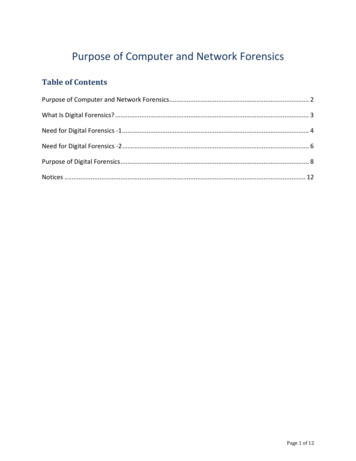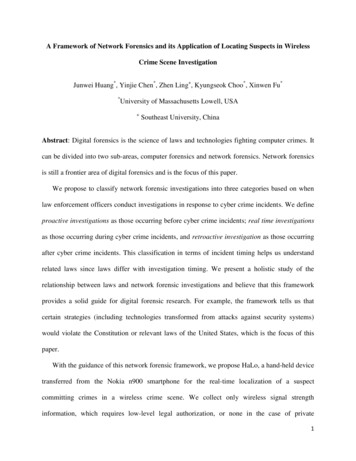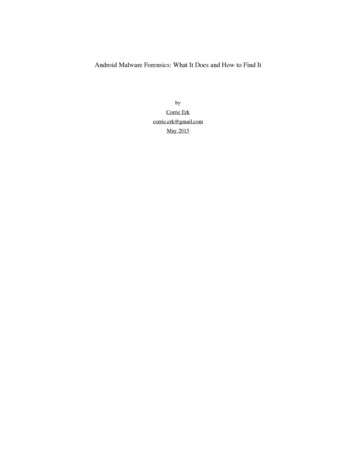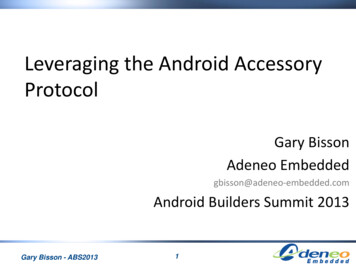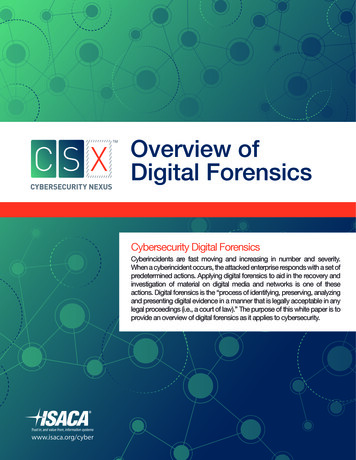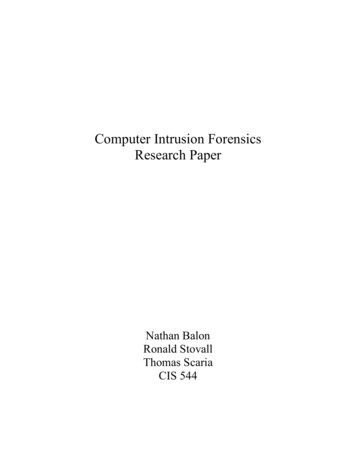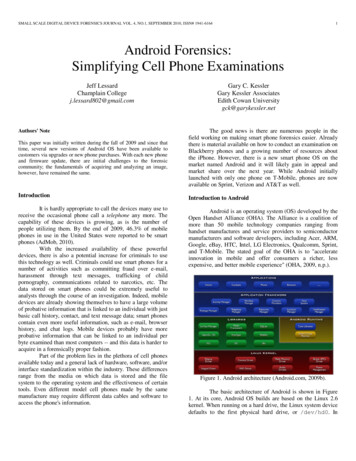
Transcription
SMALL SCALE DIGITAL DEVICE FORENSICS JOURNAL VOL. 4, NO.1, SEPTEMBER 2010, ISSN# 1941-61641Android Forensics:Simplifying Cell Phone ExaminationsJeff LessardChamplain Collegej.lessard802@gmail.comGary C. KesslerGary Kessler AssociatesEdith Cowan Universitygck@garykessler.netThis paper was initially written during the fall of 2009 and since thattime, several new versions of Android OS have been available tocustomers via upgrades or new phone purchases. With each new phoneand firmware update, there are initial challenges to the forensiccommunity; the fundamentals of acquiring and analyzing an image,however, have remained the same.The good news is there are numerous people in thefield working on making smart phone forensics easier. Alreadythere is material available on how to conduct an examination onBlackberry phones and a growing number of resources aboutthe iPhone. However, there is a new smart phone OS on themarket named Android and it will likely gain in appeal andmarket share over the next year. While Android initiallylaunched with only one phone on T-Mobile, phones are nowavailable on Sprint, Verizon and AT&T as well.IntroductionIntroduction to AndroidIt is hardly appropriate to call the devices many use toreceive the occasional phone call a telephone any more. Thecapability of these devices is growing, as is the number ofpeople utilizing them. By the end of 2009, 46.3% of mobilephones in use in the United States were reported to be smartphones (AdMob, 2010).With the increased availability of these powerfuldevices, there is also a potential increase for criminals to usethis technology as well. Criminals could use smart phones for anumber of activities such as committing fraud over e-mail,harassment through text messages, trafficking of childpornography, communications related to narcotics, etc. Thedata stored on smart phones could be extremely useful toanalysts through the course of an investigation. Indeed, mobiledevices are already showing themselves to have a large volumeof probative information that is linked to an individual with justbasic call history, contact, and text message data; smart phonescontain even more useful information, such as e-mail, browserhistory, and chat logs. Mobile devices probably have moreprobative information that can be linked to an individual perbyte examined than most computers -- and this data is harder toacquire in a forensically proper fashion.Part of the problem lies in the plethora of cell phonesavailable today and a general lack of hardware, software, and/orinterface standardization within the industry. These differencesrange from the media on which data is stored and the filesystem to the operating system and the effectiveness of certaintools. Even different model cell phones made by the samemanufacture may require different data cables and software toaccess the phone's information.Android is an operating system (OS) developed by theOpen Handset Alliance (OHA). The Alliance is a coalition ofmore than 50 mobile technology companies ranging fromhandset manufactures and service providers to semiconductormanufacturers and software developers, including Acer, ARM,Google, eBay, HTC, Intel, LG Electronics, Qualcomm, Sprint,and T-Mobile. The stated goal of the OHA is to "accelerateinnovation in mobile and offer consumers a richer, lessexpensive, and better mobile experience" (OHA, 2009, n.p.).Authors' NoteFigure 1. Android architecture (Android.com, 2009b).The basic architecture of Android is shown in Figure1. At its core, Android OS builds are based on the Linux 2.6kernel. When running on a hard drive, the Linux system devicedefaults to the first physical hard drive, or /dev/hd0. In
SMALL SCALE DIGITAL DEVICE FORENSICS JOURNAL VOL. 4, NO.1, SEPTEMBER 2010, ISSN# 1941-6164addition, Linux only understands character and block devices,such as keyboards and disk drives, respectively. With Linux onflash, however, a Flash Transition layer provides the systemdevice functionality. A Memory Technology Device (MTD) isneeded to provide an interface between the Linux OS and thephysical flash device because flash memory devices are notseen as character or block devices (Dedekind, 2009).The Android Runtime System utilizes the Dalvikvirtual machine (VM), which allows multiple applications to berun concurrently as each application is its own separate VM.Android applications (the apps of today's common parlance)are compiled into Dalvik executable (.dex) files(DalvikVM.com, 2008). During a forensic examination onewill be mainly concerned with the Libraries and, in particular,the SQLite databases. This is where one will find the majorityof data that could be of interest in an investigation. Files can bestored on either the device's storage or on the removable securedigital (SD) memory card (Android.com, 2009b).Unlike the typical desktop operating system, data orother files created by one Android app cannot automatically beviewed by other applications by default. The VM nature ofAndroid allows each application to run its own process.Security is permissions-based and attached at the process levelby assigning user and group identifiers to the applications.Application cannot interfere with each other without beinggiven the explicit permissions to do so (Android.com, 2009a).The security mechanisms of the Android OS couldimpede a forensic examination although some of the basic toolsand techniques could allow investigators to recover data fromthe device. The first, most obvious step is to perform atraditional forensics analysis of the microSD card from thephone. This is the least effective method as it can only is accessthe data that apps directly store on the SD card. SD cards usethe FAT32 file system and are easily imaged and examinedusing traditional forensics tools (including write-blockinghardware) (TalkForensics, 2009).The Android file system is Yet Another Flash FileSystem 2 (YAFFS2). YAFFS, developed in 2002, was the firstfile system designed for NAND (Not-AND) flash memorydevices. YAFFS2 was designed in 2004 in response to theavailability of larger sized NAND flash devices; older chipssupport a 512 byte page size whereas newer NAND memoryhas 2096 byte pages. YAFFS2 is backward compatible withYAFFS (Manning, 2002).Acquiring a Physical Image of an Android DeviceSince Android is still an emerging OS and, forensics isin its infancy, this section will explore the steps of the analysisof an Android device. The following methods were assembledfrom research done and methods created by theandroid/htcmodding community as well as assistance fromAndrew Hoog and ViaForensics.2Figure 2. Sprint HTC Hero (left) and information screen of testdevice (right).As of July 2010, the latest version of Androidavailable was v2.2 (Froyo) and v3.0 (Gingerbread) is expectedbefore the end of the year. The analysis described below wasperformed during the fall of 2009 on a Sprint HTC Herorunning Android v1.5 (aka Cupcake) (Figure 2). The Hero is alittle different than a standard Android phone because HTCemploys its own Sense user interface (UI) on the device, whichwill not be used on any Google-branded devices (HTC, 2009;Miller, 2009). While the Sense UI changes the look and feel ofthe device, it is uncertain how much (if any) this impacts aforensic investigation of the HTC Hero.Connecting the device via a data cableAlthough the data cable for the Hero is a proprietaryHTC cable (ExtUSB), an ordinary mini-USB cable will workfor data transfers. The HTC cable handles running music andvideo over USB and would be desired for consumerapplications but is not required for any type of forensicsanalysis.Imaging the memory cardAlthough an analysis of the removable memory of thephone has its limitation and phone system data is likely notstored to the memory card, it can still be a valuable tool.Making an image from the phone's memory card is quite simpleand normal procedures for imaging a device can be used. In theanalysis here, AccessData's FTK Imager v2.5.1 was employed.The phone first needs to be connected to theexamination machine using a write blocker to ensure theintegrity of the data. Once the phone is connected, it willprompt that the USB cable is connected and ask the user toselect to copy files to/from the host computer. Another screenthen appears asking the user to mount the device (Figure 3).
SMALL SCALE DIGITAL DEVICE FORENSICS JOURNAL VOL. 4, NO.1, SEPTEMBER 2010, ISSN# 1941-61643Figure 5. FTK Imager image summary screen.Importance of rooting the device in order to obtain a ddimageFigure 3. "USB Connected" screen.Once connected, the device will look for anynecessary appropriate drivers. If issues arise, drivers are madeavailable on HTC's website.Now in FTK Imager, go to the File pulldown menu,and select the Add Evidence open, and then choose PhysicalDrive. Select the drive that is appropriate to the Android device(Figure 4). Note that the device will be the same size as thememory card (in this case, there is an 8GB microSD card in thedevice.Figure 4. FTK Imager "Drive Selection" screen.Save the image by using the File, Export disk imageoption. Make sure to take a physical image of the entire driverather than a logical image of the partition. In this case,\\PHYSICALDRIVE5 was selected and imaged, sending theoutput to a raw dd image file. (The rationale for using dd forimage files is provided below.) As with any image file, be sureto verify the hash prior to any subsequent analysis (Figure 5).Note that the SD card should be put aside and not replaced inthe phone.The ability to physically image memory is the holygrail of mobile device forensics. The device's memory cancontain extremely valuable data, such as: the contact list, calllogs, text messages, and other phone data. Additionalinformation can also be hidden and uncovered, such as Webhistory, e-mails, images viewed on the phone, passwords, andfragments of other data. Access to memory can beaccomplished by rooting the phone.While the term rooting can have a negativeconnotation (similar to jailbreaking an iPhone), it has adifferent meaning than is generally perceived. Rooting a devicemerely means to gain access to the root directory (/) andhaving the appropriate permissions to take root actions. Themodding community -- i.e., modern day hackers (in the 1970ssense of the word) who like to modify devices beyond theintentions of the device designers or vendors -- uses the term tomean accessing the root directory/permissions and thensubstantially modifying the phone to increase battery life orperformance, run homebrewed applications, and/or installcustom firmware on the phone (Purdy, 2009). Obviously,changing the data in such a way is not forensically sound andwould not be done in an investigation.Obtaining a dd image file is possible when thepermissions are altered to gain access to the root directory. It isimportant to note that this method (at least for the Sprint HTCHero), in its current iteration, needs to have a third partyprogram installed on the device in order to get root permissionsand likely would not be admissible in a court room setting.There are different ways to gain root permissions on otherdevices that do not involve adding anything to the phone butthis is not the case on the Hero. The following method, then,should be viewed more of a proof of concept that could betailored to be forensically sound if an alternate way to obtainroot is found.USB DebuggingIn order to acquire access to the root directory,Universal Serial Bus (USB) debugging will have to be enabledon the phone. Although the default setting is “disabled,” goingto Settings, selecting Applications, choosing Development andtouching the checkbox, can turn on this function.
SMALL SCALE DIGITAL DEVICE FORENSICS JOURNAL VOL. 4, NO.1, SEPTEMBER 2010, ISSN# 1941-6164Root access will not be possible if an examinerencounters a locked Android device that does not have USBdebugging enabled. If presented with a locked device, one mayeither attempt the method and hope that USB debugging iscurrently enabled by the user or must defeat the lock screen bysome other method and then enable debugging using theoutlined method above.4# cd /system/bin# cat sh su# chmod 4755 suPreparing the Hero for rootingThe method described here is based upon descriptionsat The Unlockr.com (2009) and is the result of the work ofmany users at the XDA Developers forum (forum.xdadevelopers.com/). The Android root access software wascreated by Christopher Lais at ZenThought.org. Be sure toinsert a fresh SD card in the phone (do not replace the originalSD card in the phone as it contains evidence that this processwill alter).The first step is to set up the Android DevelopmentTools (ADT) on the host Linux, MacOS, or Windows computersystem. The ADT is part of the Android Software DevelopmentKit (SDK) (Android Developers, 2009). For a Windowssystem, download the SDK ZIP file and extract the files to thehost computer.The next step is to ensure that the phone and theAndroid development bridge (ADB) are both functioning asexpected. In the Windows command line, move to theAndroidSDK folder, navigate to the tools subfolder, andrun the adb devices command. If everything is workingproperly, a list of attached devices will show up with acorresponding serial number (Figure 6). If not presented with alist of devices, one must check that drivers are functioningproperly and that USB debugging is enabled.Figure 6. Starting the Android SDK in Windows.The method necessary to obtain root is specific toeach phone and OS varient. The following method wasdesigned for the Sprint HTC Hero running OS version 1.5 andutilizes a program called AsRoot2 (ZenThought, 2009). Thearchive needs to be downloaded and the files extracted the filesto the Tools folder and then execute the following commands(Figure 7): adb push asroot2 /data/local/ adbshellchmod0755/data/local/asroot2 adb shell /data/local/asroot2 /mtdblock3 /systemFigure 7. Obtaining root access of the Android device inWindows.If these steps all work correctly, the examiner shouldnow have root permissions and can image the Android device.It should be noted that there is no real indicator that root accessis available; to test out if it is functioning properly, continueand try to make a dd image of the memory (per the instructionsbelow).Creating a dd image of memoryThe file system of the Android device is stored in afew different places within /dev. Without the use of atraditional hard drive, the Linux kernel makes use of an MTDthat allows for the embedded OS running directly on flash (SSIEmbedded Systems, 2008). Although it may differ for otherandroid phones, there are six files of interest located in/dev/mtd/ (Android-DLs.com, 2009): mtd0 handles miscellaneous tasksmtd1holds a recovery imagemtd2 contains the boot partitionmtd3 contains system filesmtd4 holds cachemtd5 holds user dataAlthough it is important to image each file to obtainthe complete operating system, the majority of this examinationwill focus on the information in mtd3 and mtd5.In order to image memory, the Android SDK shell willneed to again be launched. As before, navigate to theAndroidSDK\tools directory, start the shell by executingthe adb shell command, and then entering the/data/local/asroot2 /system/bin/sh instruction.Once in the shell, the dd command can be used toimage the memory files, using the command (Hoog, 2009a):
SMALL SCALE DIGITAL DEVICE FORENSICS JOURNAL VOL. 4, NO.1, SEPTEMBER 2010, ISSN# 1941-6164ddif /dev/mtd/mtd0bs 1024of /sdcard/mtd0.ddThe command above will make a bit-for-bit image of the mtd0file, using a block size of 1024 bytes, and copy the image file tothe SD card. Repeat this command five more times in order toimage the remaining five files of interest (Figure 8).5and Portable Data Format (PDF) documents were recovered, aswere 12,709 BitMap (BMP), Graphics Interchange Format(GIF), Joint Photographic Experts Group (JPEG), and PortableNetwork Graphics (PNG) images.Recovered documentsMost of the recovered documents were not of a realevidentiary value. A large portion of the HTML files wereadvertisements and only four files were complete snapshots ofWeb pages (Figure 9, left). The HTML files included 28Exchangeable Image File (EXIF) data for JPEGs; thisinformation can be helpful to determine what specific cameratook an image.Figure 8. Obtaining root access of the Android device inWindows.Note that this command will direct the output to theSD card. For this reason, it is imperative that a formatted andwiped SD card is placed into the phone and that the evidentiarySD card is put aside. It is also extremely important to not mixup the input file (if) and output file (of) parameters so as tonot inadvertently destroy any data.At this point, the dd files can be analyzed using anyforensics software. Be sure to use a write-blocker whenaccessing the files on the SD card.Examination of MemoryThe examination of the memory image files wasperformed using Access Data's Forensic Tool Kit (FTK) v1.81.FTK was selected because of its data carving and searchingcapabilities; since today's forensic software does not mount theYAFFS2 file system, the ability for string searches wasparamount.When setting up the analysis in FTK, select optionsfor full indexing and data carving, and add all six files foranalysis. In this case, the subject phone was approximately twomonths old and had been used extensively for data applications.After data carving, 207 Hypertext Markup Language (HTML)Figure 9. Recovered files: Web page (left) and Google searchhistory (right).One particularly interesting document that containeduseful information was the single recovered PDF file. This filewas extremely fragmented and while Acrobat Reader reportedthat the file was corrupt and could not be opened, FTK was ableto view the contents. The file was 2 MB in size and wassubstantially larger than all of the other recovered documents. Itcontained information such as text messages, phone bookinformation, browser history, Facebook status updates, Googlesearch history (Figure 9, right), YouTube videos visited, andmusic played from the SD card. It was difficult to look through
SMALL SCALE DIGITAL DEVICE FORENSICS JOURNAL VOL. 4, NO.1, SEPTEMBER 2010, ISSN# 1941-6164because it was so fragmented but searching the document madeinformation easier to find.Recovered imagesAs on a typical computer, this Android device hadnearly 13,000 images, only some of which would be interestingin a forensics examination. The first noteworthy images foundwere the ones displayed as the phone is booting up. There arethree different images: the HTC logo, a Hero splash screen, anda Sprint screen. The HTC logo screen is displayed at two pointsin the booting process and features the HTC logo in a beveledsilver text on a reflective black background. As the phoneboots, the source of light in the image changes as it pans acrossthe logo – this seems like a loading screen, indicatingsomething is happening like a progress bar would. This logowas merely an animated GIF file.The mtd3.dd file contained images for differentapplications. Backgrounds for a labyrinth style game; imagesfor bookmarks, weather, alarm clocks, keyboards, and widgets;grids for Sudoku games; and icons for check boxes, contacts,camera, and navigation apps were found.Figure 10. Recovered images: Corrupted image file (left) andintact image file (right).The mtd4.dd file contains contents of the Androidcache. Recovered images from this location included some thatwere viewed from e-mail; some of the images were corruptedwhile others were perfectly intact (Figure 10).Interestingly, only 30 images from the user's Gmailaccount were found. The highly fragmented condition of someof these images suggests that the amount of space allowed forcaching of images viewed from Gmail is not large.Alternatively, it is possible that FTK was not able to locate oridentify the images.Another interesting result was that two of the imagesin the cache, although on the Gmail account, were neverspecifically called up or viewed on the phone. The bestexplanation is that they were preloaded from viewing the email,although the user never selected to download or view them.The mtd5.dd file contains the user data and, notsurprisingly, is where the majority of the recovered imageswere found. These were the types of pictures one would expectto find, namely images ranging from contact photos, downloads6from browser Web pages, pictures taken with the Hero's cameraand sent to someone via the Multimedia Messaging Service(MMS) or e-mail to those from applications such as Facebook,cover art from Pandora, image previews of videos fromSprintTV and YouTube, and icons from applications.SearchingWhile browsing through images and documentsyielded some helpful information, FTK was unable to locatetext messages, e-mails, contacts, and call history. The searchtool is quite powerful but in order to use it, an examiner needsto have an idea of what to search for. When trying to findemails, a logical starting point would be to search for thesuspect's e-mail address. A search for j.lessard802@gmail.com,for example, yielded 1628 hits over 92 files. The files generallystarted with the e-mail address, followed by a preview of thebody of the message and then the rest of the e-mail andrecipient information. Many of the strings found looked likethis one:j.lessard802@gmail.com .ö7 à.ö7c Ryanand Ysa I quite impressed with the talk theygave our class. Maybe impre.Ryan andYsa br br I quite impressed with the talkthey gave our class. Maybe impressed isntquite the right word for it - perhaps amazedthey let everyone in to their life like that. Inever really thought about the difficulty ofcommunicating across cultures and how itwould impact a relationship. Specifically ifthey didnt speak each others language. Iguess the international language is trulydance. br It is likely that if the suspect were using a mobile email client (such as a gmail application) would yield moremessages than a system where only Web mail has beenemployed.Figure 11. User names and passwords found in plaintext,blacked out for publication.
SMALL SCALE DIGITAL DEVICE FORENSICS JOURNAL VOL. 4, NO.1, SEPTEMBER 2010, ISSN# 1941-6164Hoog (2009b) has reported that the Android browserstores passwords in plaintext right next to a username andUniform Resource Locator (URL). As expected, several of thesearch hits found the displayed username and password forseveral Web sites, one of which yielded a piece of a databasethat held all of the password information (Figure 11). This isvery helpful for the forensic examiner although a poor securitypractice from the user perspective. While many peopleappropriately worry about saving their username and passwordinformation on their computers, and may even know how tohide those traces, most are likely less careful with similar datastored on their phone.When searching for e-mail addresses, references werefound to a file named contacts.db. After searching for thatstring, contact and phonebook information was found quiteeasily. It was located in a few different places and in pieces butthat is likely due to the fact that FTK was unable to recognizethe operating system and, before data carving, everything wasjust considered unallocated space. The actual path for ders.contacts/databases/contacts.db.7valuable files were uncovered. As before, the files were copiedto the SD card using the dd command (Figure 13):ddif /data/data/subdir/databases/file.dbof /sdcard/file.dbFigure 13. dd commands to create images of database (.db)files.Figure 14. Username and password of HTC Twitter user.Logical ExaminationFigure 15. Information about Twitter sites that the user follows.Although it is valuable to perform a physicalexamination to access deleted information that might otherwisego unnoticed, much of the data that was viewable in FTK wasfragmented and difficult to read. Looking at files logically canshow whole databases that are not fragmented.The database files found by a logical examination ofthe Android device yielded a significant amount of interestinginformation. The first such file examined was b,the database associated with htctwitter, the Twitter applicationcalled Peep, developed by HTC. This database file yieldedaccount information (including an unencrypted password)(Figure 14) as well as account information for Twitter sites thatthe user follows (Figure 15).In addition, 1460 Twitter updates were found, withdetailed information about the sender. This output also containsa field named is public, which defines whether the messagewas a private (0) or a normal tweet (1).Figure 12. Contents of the /data/data directory.Following the naming convention of the path wherecontacts.db was found, the Hero was hooked up again tothe examination machine and the directory /data/data wasinspected, and 154 subdirectories were found (Figure 12).After the process of browsing each of these folders,listing the subdirectories and looking for databases, severalFigure 17. Passwords found in plaintext.Figure 18. Data typed into browser forms.
SMALL SCALE DIGITAL DEVICE FORENSICS JOURNAL VOL. 4, NO.1, SEPTEMBER 2010, ISSN# 1941-6164Figure 19. Browser history.8Figure 23. Google apps account information.The Google applications database is found es/accounts.db. This filecontains Google apps account information, including the username and the encrypted passwords (Figure 23).Figure 20. Browser search ser/databases/browser.db is a separate database for the Android browser.The contents of this file included usernames, URLs, andplaintext passwords (Figure 17), data typed into forms (Figure18), web browser history (Figure 19) and search history(although it was thought that this information had been deleted)(Figure oid.browser/gears/geolocation.db, which stores the last known location asreported by the GPS satelites (Figure 21).Figure 21. Last known geographic location.The Google maps database can be found s/search history.db. Thisfile contains the history saved for all searches entered into theGoogle maps application (Figure 22).Figure 24. MMS/SMS message lephony/databases/ directory contains information related to themessaging applications, including picture and text messagedata. The mmssms.db database contains the MMS and ShortMessage Service (SMS) messages [Address field truncated](Figure 24). Note that the contents in this database includedsome deleted messages although no messages that were deletedmore than 45 days prior were available. It is likely that theretained deleted messages would depend on the phone andindividual user.Figure 22. Google maps database.Figure 25. Voice mail audio files.
SMALL SCALE DIGITAL DEVICE FORENSICS JOURNAL VOL. 4, NO.1, SEPTEMBER 2010, ISSN# 1941-61649example of the complete body of an e-mail can be found inFigure 29.Figure 26. Playback and analysis of voice mail audio files.Voice mail audio files are not stored in a om.coremobility.app.vnotes/files directory, using the file names VN-*.AMR (Figure 25).Adaptive Multi-Rate (AMR) files use a standard audio formatthat is commonly found in Global System for Mobile (GSM)communications cell phones (Figure 26).Figure 27. Telenav recent stops information.Telenav is the Sprint navigation application. .telenav.app.android.sprint/files directory. The most useful file appears to beANDROID TN55 recent stops.dat, which containsrecent location information (Figure 27). When viewedlogically, deleted history is not shown.Figure 29. Call history database, Number and name fieldstruncated for publication.Android phones also contain extensive call history oviders.contacts/databases/contacts.db database contains the callhistory, including the phone number, date, length of call inseconds, type of call (1 incoming, 2 outgoing, 3 missed),and name from a phonebook look up, if available (Figure 29).Figure 30. Contact history information.Otherpotentially usefulinformationincontacts.db includes contact names, number of timescontacted, the time of the most recent contact, contact photofile (if used), custom ringtone (if used), and last time thecontact information was updated (Figure 30).Figure 28. Gmail database file.Figure 31. Facebook status updates.Finally, the HTC Hero also synchronizes contact'sFacebook status updates with the phone book. That informationis also stored in contacts.db (Figure 31).Figure 29. Complete e-mail.Analysis With the rs.gmail/databases directory contains files related to Gmail,and contains information that is available when accessingGmail via the application rather than via the browser. Themailstore.j.lessard @gmail.com.db file is thedatabase for the user j.lessard@gmail.com, and includes e-mailhistory information such as sender, receiver, date received,subject, and a snippet of the message body (Figure 28). AnFor comparison purposes, a CelleBrite UniversalForensic Extraction Device (UFED) was also employed toacquire information from the phone. The UFED is a standalone hardware device that is designed to pull contact lists andaddress books, pictures, videos, music, ringtones, textmessages, call history, and device identifying information. TheUFED communicates with a cell phone via a data cable,infrared (IR), or BlueTooth (BT). Subscriber InformationModule (SIM) data can be acquired directly from the card or
SMALL SCALE DIGITAL DEVICE FORENS
SMALL SCALE DIGITAL DEVICE FORENSICS JOURNAL VOL. 4, NO.1, SEPTEMBER 2010, ISSN# 1941-6164 1 Android Forensics: Simplifying Cell Phone Examinations Jeff Lessard Gary C. Kessler Champlain College Gary Kessler Associates j.lessard802@gmail.com Edith Cowan University gck@garykessler.net Authors' Note

